And by that I mean in the continent I’m from. I wrote a post for en bici por madrid about city riding in the Pacific Northwest with a few comparisons to riding in my adopted city. Enjoy!
Archive for the 'U.S.' Category
Cycling abroad
Published Tuesday, 18 September, 2012 autobombo , cycling , Madrid , travel , U.S. ClosedTags: autobombo, cycling, travel
Non sequitur: Obama DVD game
Published Tuesday, 17 March, 2009 movies , U.S. 3 CommentsTags: Brown, DVDs, game, Obama, tag
So I’ve been suckered in to playing a game here, thanks to Tom over at
thebadrash. He details the instructions here, but the premise is that Barack Obama gave Gordon Brown 25 DVDs as a gift recently and this makes for a fun game. Tom’s rules are as follows: you get 2 points for each that you own and have watched, 1 point for those you’ve seen but don’t own, docked 1 point for those you own but have never watched, and no points for those you’ve never seen and don’t own (even if you intend to watch them this evening).
I’ve added a note about having read the books (because my score is pretty terrible, but I’m not completely hopeless). Also, Tom requests that you add one DVD of your choice to the list.
Here’s how I did (with my non-existent DVD collection):
Seen:
The Godfather, Schindler’s List, Vertigo, Chinatown, Some Like It Hot, ET: The Extra-Terrestrial, Citizen Kane, The Wizard Of Oz, It’s A Wonderful Life, The Graduate, Casablanca (11 points)
Haven’t seen:
Raging Bull, Psycho, Lawrence Of Arabia, Singin’ In the Rain, Gone With The Wind, Star Wars Episode IV, 2001: A Space Odyssey, On The Waterfront, City Lights, The Searchers, Sunset Boulevard, The General
Read more than once and feel like I’ve seen:
The Grapes Of Wrath, To Kill a Mockingbird
As for the film to add:
Do the Right Thing
And I’m going to continue Tom’s chain by tagging Leftbanker, Selfish Crab, Amy, and Raronauer.
Giving thanks
Published Monday, 1 December, 2008 cooking , eating , food , holidays , U.S. 4 CommentsTags: acción de gracias, dinner, friends, Madrid, Spain, thanksgiving
My roommates have been asking me to make a Thanksgiving turkey since I arrived in Madrid more than three years ago. But this September some friends made a proposal for the dinner and, mainly since an American friend agreed to brave the Thanksgiving cooking with me, I acquiesced. Needless to say, my roommates were a bit miffed. But they got some leftovers and my practice pumpkin pie.
Spaniards are intrigued by Thanksgiving, probably because it’s at once strangely foreign yet familiar. (If my students are any guide, they appear to get most of their idea of Thanksgiving from films or TV.) But they are also drawn to the holiday because it has a rather universal appeal: eating with those you care about and giving thanks for whatever you feel like, no strings (in the form of religion and/or gifts) attached. Several students threatened to show up at our dinner after I told them everything we were going to cook and the butcher I bought the turkey from was more than happy to be of assistance in our preparation for the big day.
After weeks of planning, inviting, and coordinating, and a solid 12 hours of cooking the day before, Thanksgiving Saturday began with a 9 am trip to the butcher to retrieve the turkey. I watched, eyes bugged out, as he slung the naked 7.5-kilo bird onto his chest for the short trip from fridge to counter, where, at our request, he hacked off the remaining stump of the neck with one swift blow of the cleaver. And he put our dear pava (that’s right, it was a female) in a plastic bag, swiped my debit card, and sent us on our way with wishes for a happy día de acción de gracias.
And about nine hours later, after stuffing our bird and fitting her into the pan, washing and steaming three kilos of Swiss chard, making several kilos of mashed potatoes, improvising gravy, and reheating sweet potatoes, roasted carrots, red cabbage, and broccoli casserole, fourteen people sat around the table and were thankful.
Organic fruit and veg
Published Wednesday, 15 October, 2008 cooking , eating , food , Madrid , U.S. 8 CommentsTags: food, fruit, Madrid, organic, Spain, vegetables
After a month in the States this summer eating amazing pesticide-free local fruit and vegetables both in upstate New York and in the D.C. area, I decided I’d try to change the way I eat my greens in Madrid. Neither the CSA model, which has spread like wildfire across the United States and Canada, nor local farmers markets really exist in Spain (or Madrid, at least) to the extent that they do on the other side of the pond. Generally the produce you can get in Spain is quite good, and much of it is from somewhere in the country, but it’s not always easy to know where it’s coming from, or how many pesticides have been used to grow it. I do have a good natural foods store in my neighborhood, and there are a number of these throughout the city, but the produce has never looked particularly great.
So this month a friend and I have ventured into the world of weekly organic fruit and vegetable boxes. While these are not exactly CSA, they are an opportunity to buy boxes of seasonal, organic produce from farms. Both places we’ve ordered from have been just under 300 miles from Madrid, which is not incredibly local, but relatively speaking, it’s not bad. The first was Daiquí, a farm in Ourense, Galicia (northwest of Madrid), where we paid 25 euros (including delivery to my flat) for a 10 kilo box that included Swiss chard, apples, green beans, adorable little green peppers, potatoes, a huge zucchini, a beet, and lovely heirloom tomatoes. All of it was really delicious, and very fresh. I’ve just checked the Daiquí website, and it seems that you can no longer request the box, you have to order things by weight, like an online store. Though I’m guessing the seasonal box will make a comeback.
At any rate, we’ve now signed up for four boxes from a farm in Lleida, Cataluña (northeast of Madrid) that has a lot of promise. It’s called Recapte, and you can sign up for a minimum of four boxes and as much as a weekly box for a year. Each box is 30 euros, also including delivery to your house. What I like about Recapte is that every week they post the available fruit and vegetables on their website and you can choose the 10 things that you want in your box (you have a choice of more than double that number). You can also take a week off by notifying them that Monday.
We received the delivery from Recapte today. It was much greater in quantity than last week’s box from Daiquí and included—as requested—apples, peaches, pears, tomatoes, carrots, rainbow chard, cucumbers, lettuce, red peppers, and sweet potatoes. It all looks quite good and I can’t wait to start cooking and eating it.
It’s the little things
Published Wednesday, 27 February, 2008 food , U.S. 1 CommentTags: food, peanut butter, Spain, U.S.
 If there’s one thing that shows my true American-ness it’s got to be my love of peanut butter.
If there’s one thing that shows my true American-ness it’s got to be my love of peanut butter.
It all comes down to the fact that I consider it a kitchen staple, much like milk or bread. With peanut butter you can have a meal. It works with bread, with fruit, by itself. And it’s totally tasty and pretty nutritious to boot.
But in Spain you might as well be talking about frog eggs or something. Peanut what? they say. How do you eat that? They don’t really get it.
So it’s become something I always bring back with me after a trip home, or ask visitors to bring me. I like the natural stuff, just peanuts and oil, and maybe some salt. In desperate times I’ve been known to make it myself (try it! all you need are a bunch of peanuts and some oil and a good ol’ stick blender!). And most recently I resorted to buying it at the natural foods store where a tiny jar costs the equivalent of well over $5.
And tonight a student who was just in the U.S. brought me a jar, though I had barely mentioned the word to him. He brought natural, too. I couldn’t be happier.
Of Presidents and Prime Ministers
Published Saturday, 23 February, 2008 election , Madrid , U.S. 5 CommentsTags: campaigns, elections, presidents, prime ministers
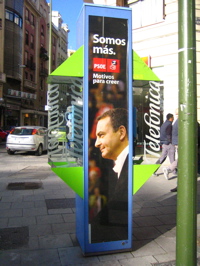 You wouldn’t know it, but Spain also has important elections this year–in fact, the real thing (no such thing as primaries here) takes place in only three weeks. In the past weeks, Madrid’s streets have filled with the faces of the right- and left-wing candidates for prime minister (Rajoy and Zapatero, respectively) on light-post banners, on phone booths (see picture), in the metro, on the highway… As for the advertising I’ve seen, the left-wing PSOE has been doing much better than the right PP, mostly because PSOE ads are EVERYWHERE.
You wouldn’t know it, but Spain also has important elections this year–in fact, the real thing (no such thing as primaries here) takes place in only three weeks. In the past weeks, Madrid’s streets have filled with the faces of the right- and left-wing candidates for prime minister (Rajoy and Zapatero, respectively) on light-post banners, on phone booths (see picture), in the metro, on the highway… As for the advertising I’ve seen, the left-wing PSOE has been doing much better than the right PP, mostly because PSOE ads are EVERYWHERE.
Yesterday, a huge vinyl ad appeared on the entire façade of a building on Gran Vía. It features photographs of the top three ministers of each party sitting in a congressional session. The top row is the PSOE, smiling and animated, and below them are the three representatives of the PP, frowning and lost in thought. And in between the two rows of photos the slogan: No es lo mismo (It’s not the same). I think it’s marvelously clever, personally. Or maybe I’m just on an advertising kick because I now teach a class at an advertising agency?
It’s a little less exciting than what’s going on at home (most of my students seem to agree with that statement), but it’s still got entertainment value.
I’ve been doing a little bit of traveling up the East Coast and have witnessed more examples of people getting their acts together and getting green.
1) In New York, I came across this banner in Columbus Circle: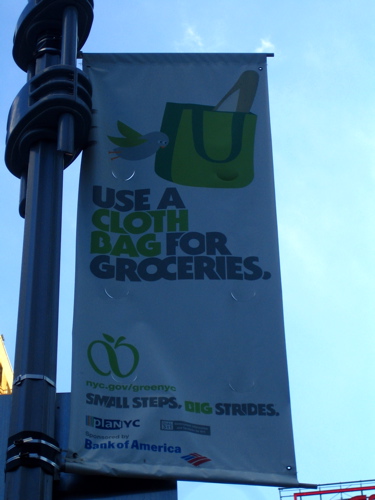 , which was just a few yards from some serious subway construction and a sign indicating that the new Columbus Circle station will be environmentally efficient when it’s finished as part of a commitment by the MTA to make New York City transit more environmentally sustainable. The above banner is part of the GreeNYC campaign.
, which was just a few yards from some serious subway construction and a sign indicating that the new Columbus Circle station will be environmentally efficient when it’s finished as part of a commitment by the MTA to make New York City transit more environmentally sustainable. The above banner is part of the GreeNYC campaign.
2) A college friend of mine who lives in Brooklyn told me she’s been fined $50 several times for not recycling properly. She is now a very vigilant recycler.
3) At the Clark Park Farmer’s Market in West Philadelphia most people were toting cloth shopping bags. Yes, they were also inevitably using some plastic bags.
In this era of global regret about global warming, my sense of the environmentally correct has grown more acute. I inevitably come back to the United States and notice the ways in which Americans are confronting the issues: the proliferation of hybrid (gas-electric) cars, the emphasis on buying local/seasonal/organic food, the increasing use of reusable shopping bags, etc etc. I’m conscious that I’m from one of the more progressive-minded and financially comfortable regions of the country (the Maryland suburbs of Washington, D.C.), but I’ve been surprised by the number of Toyota Prius hybrids I see driving around and the crowds at local farmers’ markets. The U.S. may have one of the more egregious environmental records in the world, but I’m seeing hopeful behavior–at least in my neighborhood.
When I moved to Madrid two years ago I lauded what I saw as an environmentally efficient society. Many people don’t use clothes dryers, cars are small (tiny compared to American cars!), more waste is recyclable (in the States there are many restrictions on what one can recycle, especially in terms of plastics), the use of buses and trains to travel is very widespread, and so on.
But I’ve realized that though these things are environmentally sustainable, they are bred of necessity more than anything else. To put it simply, there’s no space for big cars in Spain, and they would be so expensive to fuel that they would be beyond most people’s means. There’s not much room in people’s pisos for clothes dryers and the weather is good enough in most parts of the country to air dry clothes fairly rapidly. Europe is generally green, but maybe it’s because it has to be.
In terms of agriculture, Spain is fortunate to be a medium-sized country that cultivates a large variety of crops, meaning produce does not travel terribly far within the country, which we all know is good for carbon emissions. But not much of that produce is organic: while productos biológicos have made some inroads they are largely limited to small specialty stores and are far from entering the mainstream. In addition, one of the largest agriculture-producing regions is the desert-like Almería, which cultivates under a blanket of plastic. The “sea of plastic” that has come to symbolize the southeast corner of Spain is not environmentally sustainable or natural: they’re growing tomatoes in winter for heaven’s sake, and they’re not growing them in soil.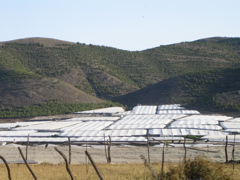
Whereas in the United States there’s a growing acceptance of the need to “buy local” and “buy seasonal,” modern Spain has let that old-fashioned practice fall by the wayside in the face of better technology (year-round greenhouse cultivation in a desert). Seventy percent of the crops cultivated in Almería are for export.
I don’t intend to make any judgments here about environmental policy, but I do believe that, at least in some parts of the U.S., we are seeing a grass roots movement towards a sustainable future and it gives me hope.




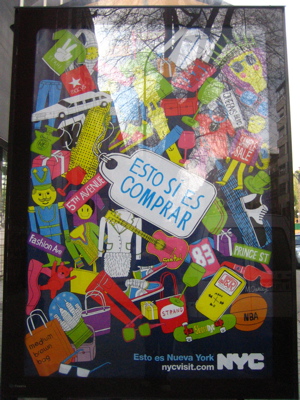

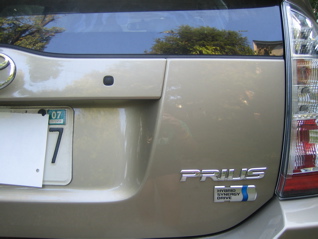

Recent Comments